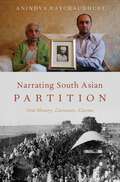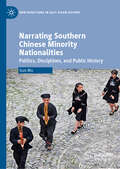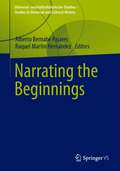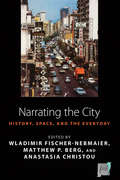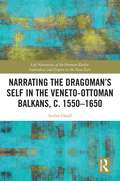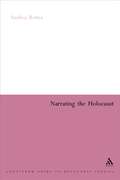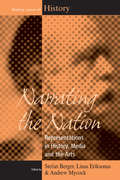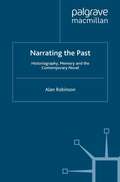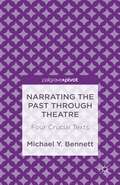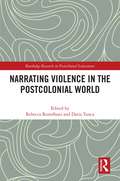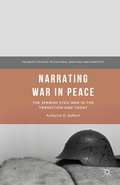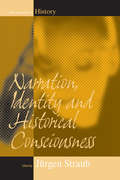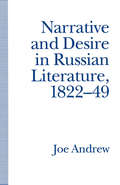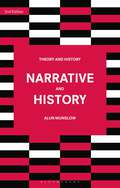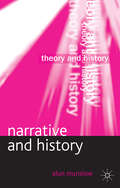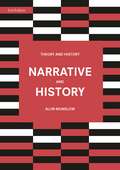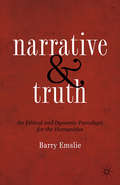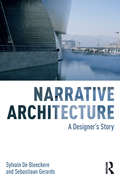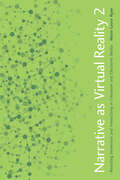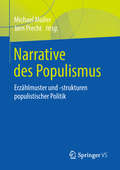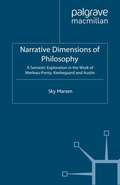- Table View
- List View
Narrating South Asian Partition: Oral History, Literature, Cinema (Oxford Oral History Series)
by Anindya RaychaudhuriThe history of the 1947 Indian/Pakistani partition is one of separation: a country and people newly divided. However, in telling this story, Anindya Raychaudhuri, the son of a partition participant, looks to unity, joining for the first time the public and private memory narratives of this pivotal moment in time. Narrating Partition features in-depth interviews with more than 120 individuals across India, Pakistan, Bangladesh, and the United Kingdom, each reflecting on a direct or inherited experience of the 1947 Indian/Pakistani partition. Through the collection of these oral history narratives, Raychaudhuri is able to place them into comparison with the literary, cinematic, and artistic representations of partition, and in doing so, examine the ways this event is remembered, re-interpreted, and reconstructed--and the narrator's role in this process. These stories also reflect on the themes of home, family, violence, childhood, trains, and rivers within these public and private narratives. Crucially, Raychaudhuri is the first writer to use oral history in addressing the Bengal/Punjab partition as part of this same event, examining the memorial legacy in both the Bengali and Punjabi communities.
Narrating South Asian Partition: Oral History, Literature, Cinema (Oxford Oral History Series)
by Anindya RaychaudhuriThe history of the 1947 Indian/Pakistani partition is one of separation: a country and people newly divided. However, in telling this story, Anindya Raychaudhuri, the son of a partition participant, looks to unity, joining for the first time the public and private memory narratives of this pivotal moment in time. Narrating Partition features in-depth interviews with more than 120 individuals across India, Pakistan, Bangladesh, and the United Kingdom, each reflecting on a direct or inherited experience of the 1947 Indian/Pakistani partition. Through the collection of these oral history narratives, Raychaudhuri is able to place them into comparison with the literary, cinematic, and artistic representations of partition, and in doing so, examine the ways this event is remembered, re-interpreted, and reconstructed--and the narrator's role in this process. These stories also reflect on the themes of home, family, violence, childhood, trains, and rivers within these public and private narratives. Crucially, Raychaudhuri is the first writer to use oral history in addressing the Bengal/Punjab partition as part of this same event, examining the memorial legacy in both the Bengali and Punjabi communities.
Narrating Southern Chinese Minority Nationalities: Politics, Disciplines, and Public History (New Directions in East Asian History)
by Guo WuBased on fieldwork, archival research, and interviews, this book critically examines the building of modern Chinese discourse on a unified yet diverse Chinese nation on various sites of knowledge production. It argues that Chinese ideology on minority nationalities is rooted in modern China's quest for national integration and political authority. However, it also highlights the fact that the complex process of conceptualizing, investigating, classifying, curating, and writing minority history has been fraught with disputes and contradictions. As such, the book offers a timely contribution to the current debate in the fields of twentieth-century Chinese nationalism, minority policy, and anthropological practice.
Narrating the Beginnings (Universal- und kulturhistorische Studien. Studies in Universal and Cultural History)
The present book is a compilation of studies on narratives of mythical origins in different cultures written by outstanding specialists. It aims to provide a broad view on creation-myths from different times and areas of the world with a particular focus on how these texts contributed to the conception of the past as “universal history”, as a common origin of mankind or as the great opening, the theatrum mundi. On the other hand, the purpose of this book is to study the phenomenon from a typological point of view, analyzing the specific characteristics of this particular type of texts, rather than finding influences between the different cultures in the genesis of these narratives.
Narrating the City: Histories, Space and the Everyday (Space and Place #15)
by Wladimir Fischer-Nebmaier Matthew P. Berg Anastasia ChristouIn recent decades, the insight that narration shapes our perception of reality has inspired and influenced the most innovative historical accounts. Focusing on new research, this volume explores the history of non-elite populations in cities from Caracas to Vienna, and Paris to Belgrade. Narration is central to the theme of each contribution, whether as a means of description, a methodological approach, or basic story telling. This book brings together research that both asks classical socio-historical questions and takes narration seriously, engaging with novels, films, local history accounts, petitions to municipal authorities, and interviews with alternative cinema activists.
Narrating the Dragoman’s Self in the Veneto-Ottoman Balkans, c. 1550–1650 (Life Narratives of the Ottoman Realm: Individual and Empire in the Near East)
by Stefan HanßThis microhistory of the Salvagos—an Istanbul family of Venetian interpreters and spies travelling the sixteenth- and seventeenth-century Mediterranean—is a remarkable feat of the historian’s craft of storytelling. With his father having been killed by secret order of Venice and his nephew to be publicly assassinated by Ottoman authorities, Genesino Salvago and his brothers started writing self-narratives. When crossing the borders of words and worlds, the Salvagos’ self-narratives helped navigate at times beneficial, other times unsettling entanglements of empire, family, and translation. The discovery of an autobiographical text with rich information on Southeastern Europe, edited here for the first time, is the starting point of this extraordinary microbiography of a family’s intense struggle for manoeuvring a changing world disrupted by competition, betrayal, and colonialism. This volume recovers the Venetian life stories of Ottoman subjects and the crucial role of translation in negotiating a shared but fragile Mediterranean. Stefan Hanß examines an interpreter’s translational practices of the self and recovers the wider Mediterranean significance of the early modern Balkan contact zone. Offering a novel conversation between translation studies, Mediterranean studies, and the history of life-writing, this volume argues that dragomans’ practices of translation, border-crossing, and mobility were key to their experiences and performances of the self. This book is an indispensable reading for the history of the early modern Mediterranean, self-narratives, Venice, the Ottoman Empire, and Southeastern Europe, as well as the history of translation. Hanß presents a truly fascinating narrative; a microhistory full of insights and rich perspectives.
Narrating the Dragoman’s Self in the Veneto-Ottoman Balkans, c. 1550–1650 (Life Narratives of the Ottoman Realm: Individual and Empire in the Near East)
by Stefan HanßThis microhistory of the Salvagos—an Istanbul family of Venetian interpreters and spies travelling the sixteenth- and seventeenth-century Mediterranean—is a remarkable feat of the historian’s craft of storytelling. With his father having been killed by secret order of Venice and his nephew to be publicly assassinated by Ottoman authorities, Genesino Salvago and his brothers started writing self-narratives. When crossing the borders of words and worlds, the Salvagos’ self-narratives helped navigate at times beneficial, other times unsettling entanglements of empire, family, and translation. The discovery of an autobiographical text with rich information on Southeastern Europe, edited here for the first time, is the starting point of this extraordinary microbiography of a family’s intense struggle for manoeuvring a changing world disrupted by competition, betrayal, and colonialism. This volume recovers the Venetian life stories of Ottoman subjects and the crucial role of translation in negotiating a shared but fragile Mediterranean. Stefan Hanß examines an interpreter’s translational practices of the self and recovers the wider Mediterranean significance of the early modern Balkan contact zone. Offering a novel conversation between translation studies, Mediterranean studies, and the history of life-writing, this volume argues that dragomans’ practices of translation, border-crossing, and mobility were key to their experiences and performances of the self. This book is an indispensable reading for the history of the early modern Mediterranean, self-narratives, Venice, the Ottoman Empire, and Southeastern Europe, as well as the history of translation. Hanß presents a truly fascinating narrative; a microhistory full of insights and rich perspectives.
Narrating the Holocaust
by Andrea Reiter Patrick CamillerIn this literary study of memoirs describing at first hand the horrors of German concentration camps, the principal question asked is: How did the survivors find the words to talk about experiences hitherto unknown, even unimaginable? Beyond being a mere analysis of discourse, Narrating the Holocaust reflects the situations in camp that triggered these responses, and shows how the professional authors adapted certain literary genres (e.g. the travel story, the Hassidic tale) to serve as models for communication, while the vast majority who were not trained as writers merely used the form of the report. A comparison between these memoirs and the more frequently discussed camp novel identifies the different narrative strategies by which the two are determined. Most of the 130 texts discussed here were published in German between l934 and the present; some famous Italian, French and Polish texts have also been included for comparison.
Narrating the Nation: Representations in History, Media and the Arts (Making Sense of History #11)
by Stefan Berger Linas Eriksonas Andrew MycockA sustained and systematic study of the construction, erosion and reconstruction of national histories across a wide variety of states is highly topical and extremely relevant in the context of the accelerating processes of Europeanization and globalization. However, as demonstrated in this volume, histories have not, of course, only been written by professional historians. Drawing on studies from a number of different European nation states, the contributors to this volume present a systematic exploration, of the representation of the national paradigm. In doing so, they contextualize the European experience in a more global framework by providing comparative perspectives on the national histories in the Far East and North America. As such, they expose the complex variables and diverse actors that lie behind the narration of a nation.
Narrating the Past: Historiography, Memory and the Contemporary Novel
by A. RobinsonIn recent years controversy has surrounded the narrative turn in history and the historical turn in fiction. This book clarifies what is at stake, tracing connections between historiography and life-writing, arguing that the challenges posed in representing the past illuminate issues which are central to all literary narrative.
Narrating the Past through Theatre: Four Crucial Texts
by M. BennettThis cutting-edge title explores how narrating the past both conflicts and creates an interesting relationship with drama's 'continuing present' that arcs towards an unpredictable future. Theatre both brings the past alive and also fixes it, but through the performance process, allowing the past to be molded for future (not-yet-existent) audiences.
Narrating Violence in the Postcolonial World (Routledge Research in Postcolonial Literatures)
by Rebecca Romdhani Daria TuncaThis book examines representations of violence across the postcolonial world—from the Americas to Australia—in novels, short stories, plays, and films. The chapters move from what appear to be interpersonal instances of violence to communal conflicts such as civil war, showing how these acts of violence are specifically rooted in colonial forms of abuse and oppression but constantly move and morph. Taking its cue from theories in such fields as postcolonial, violence, gender, and trauma studies, the book thus shows that violence is slippery in form, but also fluid in nature, so that one must trace its movement across time and space to understand even a single instance of it. When analysing such forms and trajectories of violence in postcolonial creative writing and films, the contributors critically examine the ethical issues involved in narrating abuse, depicting violated bodies, and presenting romanticized resolutions that may conceal other forms of violence.
Narrating Violence in the Postcolonial World (Routledge Research in Postcolonial Literatures)
by Rebecca Romdhani Daria TuncaThis book examines representations of violence across the postcolonial world—from the Americas to Australia—in novels, short stories, plays, and films. The chapters move from what appear to be interpersonal instances of violence to communal conflicts such as civil war, showing how these acts of violence are specifically rooted in colonial forms of abuse and oppression but constantly move and morph. Taking its cue from theories in such fields as postcolonial, violence, gender, and trauma studies, the book thus shows that violence is slippery in form, but also fluid in nature, so that one must trace its movement across time and space to understand even a single instance of it. When analysing such forms and trajectories of violence in postcolonial creative writing and films, the contributors critically examine the ethical issues involved in narrating abuse, depicting violated bodies, and presenting romanticized resolutions that may conceal other forms of violence.
Narrating War in Peace: The Spanish Civil War in the Transition and Today (Palgrave Studies in Cultural Heritage and Conflict)
by Katherine O. StaffordThrough case studies of prominent cultural products, this book takes a longitudinal approach to the influence and conceptualization of the Civil War in democratic Spain. Stafford explores the stories told about the war during the transition to democracy and how these narratives have morphed in light of the polemics about historical memory.
Narration, Identity, and Historical Consciousness (Making Sense of History #3)
by Jürgen StraubA generally acknowledged characteristic of modern life, namely the temporalization of experience, inextricable from our intensified experience of contingency and difference, has until now remained largely outside psychology’s purview. Wherever questions about the development, structure, and function of the concept of time have been posed – for example by Piaget and other founders of genetic structuralism – they have been concerned predominantly with concepts of "physical", chronometrical time, and related concepts (e.g., "velocity"). All the contributions to the present volume attempt to close this gap. A larger number are especially interested in the narration of stories. Overviews of the relevant literature, as well as empirical case studies, appear alongside theoretical and methodological reflections. Most contributions refer to specifically historical phenomena and meaning-constructions. Some touch on the subjects of biographical memory and biographical constructions of reality. Of all the various affinities between the contributions collected here, the most important is their consistent attention to issues of the constitution and representation of temporal experience.
Narrative and History (Theory and History)
by Alun MunslowBased on the assumption that reality, reference and representation work together, this introductory textbook explains and illustrates the various ways in which historians write the past as history. For the first time, the full range of leading narrative theorists such as Paul Ricoeur, Hayden White, Frank Ankersmit, Seymour Chatman and Gérard Genette have been brought together to explain the narrative-making choices all author-historians make when creating historical explanations. Combining theory with practice, Alun Munslow expands the boundaries of the discipline and charts a new role for unconventional historical forms and modes of expression. Clear but comprehensive, this is an ideal resource for undergraduate and postgraduate students taking courses on History and Theory, History and Method, and Historiography.
Narrative and History (Theory and History)
by Alun MunslowBased on the assumption that reality, reference and representation work together, Narrative and History explains and illustrates the various ways in which historians write the past as history. For the fist time, the full range of leading narrative theorists such as Paul Ricoeur, Hayden White, Frank Ankersmit, Seymour Chatman and Gérard Genette have been brought together to explain the narrative-making choices all author-historians make when creating historical explanations.Narrative and History:- considers the range of author-historian decisions through key concepts such as epistemological and aesthetic choice, ethics and ideology, emplotment and argument- defines and illustrates the functions of narrating and narration, authorial voice, characterisation and the timing of the text- explores in detail the consequences for truth, objectivity, meaning, the role of experimental history, and history representation beyond the textual in film, TV, public history, performance and digitization.Combining theory with practice, Alun Munslow expands the boundaries of the discipline and charts a new role for unconventional historical forms and modes of expression.
Narrative and History (Theory and History)
by Alun MunslowBased on the assumption that reality, reference and representation work together, this introductory textbook explains and illustrates the various ways in which historians write the past as history. For the first time, the full range of leading narrative theorists such as Paul Ricoeur, Hayden White, Frank Ankersmit, Seymour Chatman and Gérard Genette have been brought together to explain the narrative-making choices all author-historians make when creating historical explanations. Combining theory with practice, Alun Munslow expands the boundaries of the discipline and charts a new role for unconventional historical forms and modes of expression.Clear but comprehensive, this is an ideal resource for undergraduate and postgraduate students taking courses on history and theory, history and method, and historiography.
Narrative and Truth: An Ethical and Dynamic Paradigm for the Humanities
by Barry EmslieIn this book, Emslie establishes that narrative explanations are to be preferred over non-narrative in the humanities. They are more truthful in two senses. They both correspond more closely to reality and allow inference as to normative values. This is particularly the case when aesthetics are added to the mix.
Narrative Architecture: A Designer's Story
by Sylvain De Bleeckere Sebastiaan GerardsNarrative Architecture explores the postmodern concept of narrative architecture from four perspectives: thinking, imagining, educating, and designing, to give you an original view on our postmodern era and architectural culture. Authors Sylvain De Bleeckere and Sebastiaan Gerards outline the ideas of thinkers, such as Edmund Husserl, Paul Ricoeur, Emmanuel Levinas, and Peter Sloterdijk, and explore important work of famous architects, such as Daniel Libeskind and Frank Gehry, as well as rather underestimated architects like Günter Behnisch and Sep Ruf. With more than 100 black and white images this book will help you to adopt the design method in your own work.
Narrative Architecture: A Designer's Story
by Sylvain De Bleeckere Sebastiaan GerardsNarrative Architecture explores the postmodern concept of narrative architecture from four perspectives: thinking, imagining, educating, and designing, to give you an original view on our postmodern era and architectural culture. Authors Sylvain De Bleeckere and Sebastiaan Gerards outline the ideas of thinkers, such as Edmund Husserl, Paul Ricoeur, Emmanuel Levinas, and Peter Sloterdijk, and explore important work of famous architects, such as Daniel Libeskind and Frank Gehry, as well as rather underestimated architects like Günter Behnisch and Sep Ruf. With more than 100 black and white images this book will help you to adopt the design method in your own work.
Narrative as Virtual Reality 2: Revisiting Immersion and Interactivity in Literature and Electronic Media (Parallax: Re-visions of Culture and Society)
by Marie-Laure RyanIs there a significant difference between engagement with a game and engagement with a movie or novel? Can interactivity contribute to immersion, or is there a trade-off between the immersive "world" aspect of texts and their interactive "game" dimension? As Marie-Laure Ryan demonstrates in Narrative as Virtual Reality 2, the questions raised by the new interactive technologies have their precursors and echoes in pre-electronic literary and artistic traditions. Approaching the idea of virtual reality as a metaphor for total art, Ryan applies the concepts of immersion and interactivity to develop a phenomenology of narrative experience that encompasses reading, watching, and playing. The book weighs traditional literary narratives against the new textual genres made possible by the electronic revolution of the past thirty years, including hypertext, electronic poetry, interactive drama, digital installation art, computer games, and multi-user online worlds like Second Life and World of Warcraft.In this completely revised edition, Ryan reflects on the developments that have taken place over the past fifteen years in terms of both theory and practice and focuses on the increase of narrativity in video games and its corresponding loss in experimental digital literature. Following the cognitive approaches that have rehabilitated immersion as the product of fundamental processes of world-construction and mental simulation, she details the many forms that interactivity has taken�or hopes to take�in digital texts, from determining the presentation of signs to affecting the level of story.
Narrative des Populismus: Erzählmuster und -strukturen populistischer Politik
by Michael Müller Jørn PrechtPopulistische Ideologeme und populistische Kommunikation beruhen auf Narrativen, also erzählerischen Grundmustern, die gesellschaftliche Denkmuster abbilden. Eine narrative Analyse dieser Muster führt zu einem besseren Verständnis des Phänomens des Populismus. In diesem Band setzen sich die Autoren mit diesen Erzählmustern und -strukturen populistischer Politik auseinander und stellen die Frage nach dem Zusammenhang politischer und medialer Diskurse im thematischen Feld des Populismus.Der InhaltPopulismus - Versuch einer begrifflichen Differenzierung • Umrisse des populistischen Narrativs als Identitätspolitik • Narrative der Demokratie • Volkserzählungen • Eklektizismus populistischer Narrative • Populistische Narrative im sozialen Netzwerk • Erzählformen des Populismus • Populismus in den LeitmedienDie HerausgeberDr. Michael Müller ist Professor für Medienkonzeption und Medienanalyse, Semiotik und Erzähltheorie. Er leitet das Institut für Angewandte Narrationsforschung (IANA) der Hochschule der Medien in Stuttgart.Jørn Precht ist Professor für Transmediales Storytelling, Dramaturgie und Stoffentwicklung für AV- und Online-Medien an der Hochschule der Medien in Stuttgart und leitet dort das Institut für Angewandte Narrationsforschung (IANA).
Narrative Dimensions of Philosophy: A Semiotic Exploration of the Work of Merleau-Ponty, Kierkegaard and Austin
by S. MarsenThat knowledge about the world and self is imparted through narrative is widely accepted; the techniques used to construct this knowledge have received less attention. This book uses a semiotic methodology to analyze works by Merleau-Ponty, Kierkegaard and Austin, and explore how conceptualizations of reality are formed through narrative strategy.
